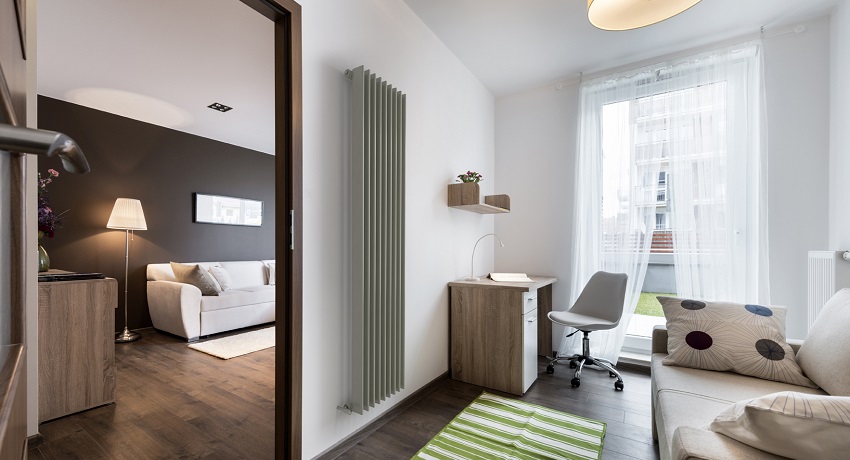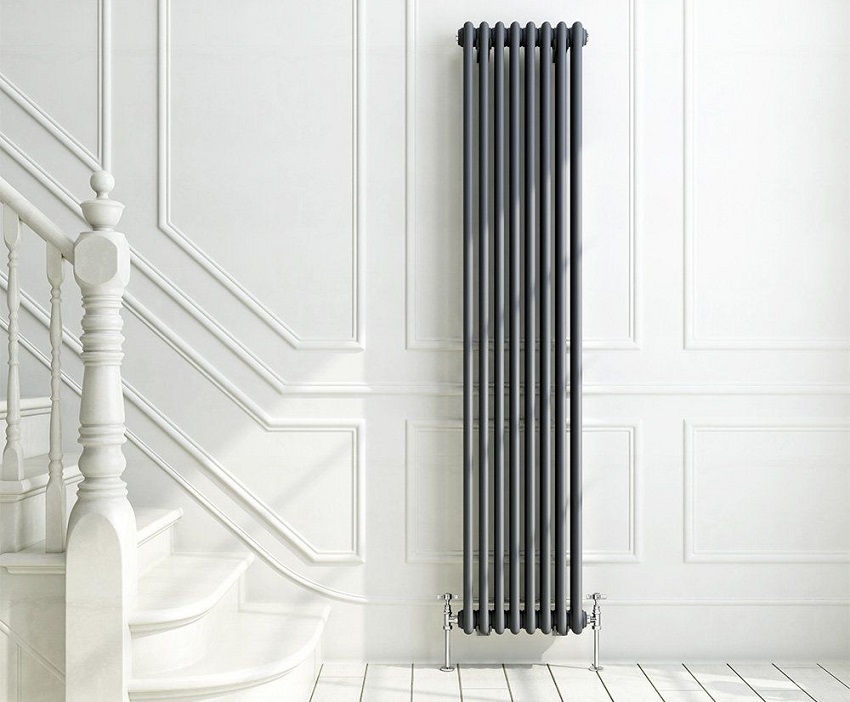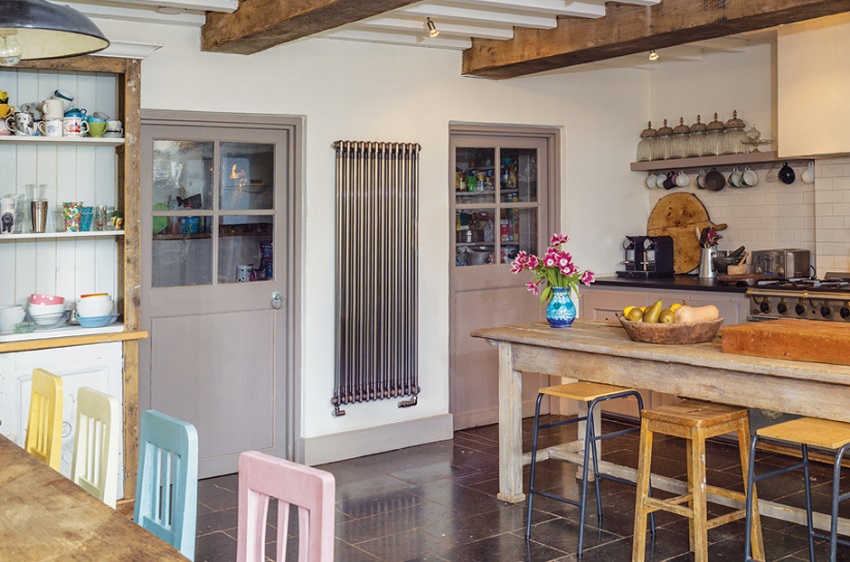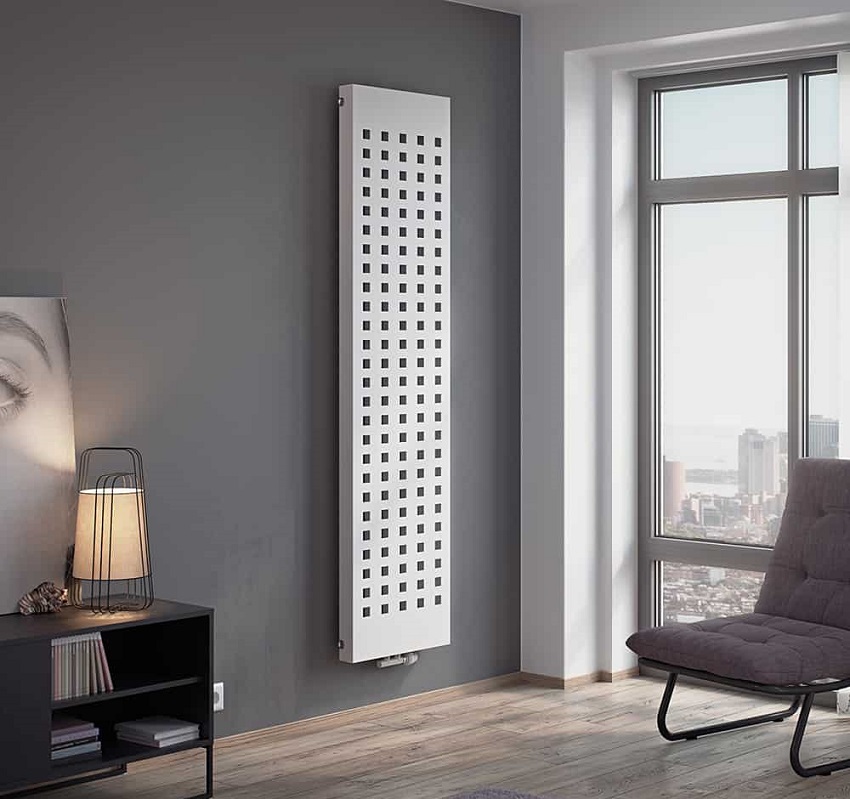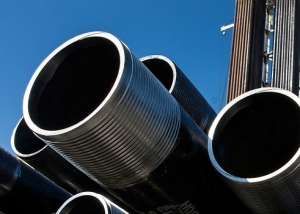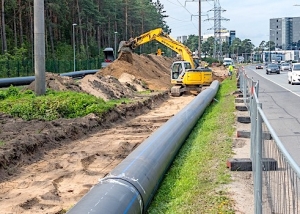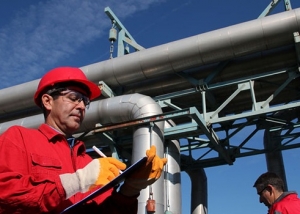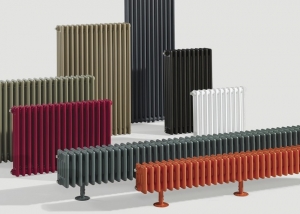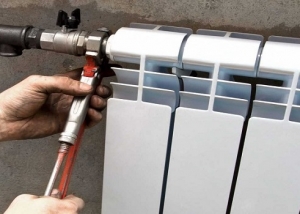The most important part of the heating system in the room is radiators. Most construction projects include installing batteries under the windows, but this is not always rational and technically justified. With panoramic glazing of the room, such installation is generally impossible. Vertical wall-mounted radiators are a modern solution that allows solving the problem of placement of devices and increasing the heating power.
Content
Types of vertical radiators
Vertical radiators by design type and operating principle do not differ from traditional (horizontal) batteries. Only their appearance changes - the height of each section increases, and the overall width decreases. This saves a lot of space, and also gives the original design to the room. The radiator connection diameter is standard: 15 mm (1/2 inch) or 20 mm (3/4 inch). Some models have 25 mm (1 inch). Eyeliner is mainly used bottom.
Vertical models by type of construction are divided into cast iron, aluminum, steel, bimetal.
Cast iron batteries
They have high heat dissipation, are protected from water shocks and pressure drops, are durable, and are not subject to corrosion. After heating, cast iron retains heat well. Such heating devices can be used in systems with centralized or autonomous heating supply. Modern vertical cast-iron radiators have a variety of design solutions, which is why they are mainly used for retro-style interiors. In this case, it is necessary to purchase special fittings that are appropriate for the design (taps, adapters, plugs, brackets).
Due to the large mass and installation complexity, cast-iron vertical batteries are used less frequently than other types. Their weight imposes a limit on the height of the section - a maximum of 1.5 meters. The heating area is up to 30 m2.
Important! Install cast iron vertical radiators only on load-bearing walls, if possible additionally fixing them to the floor with special legs.
Aluminum heating batteries
They have high heat dissipation, low weight, ease of installation, high resource. When you turn on the heating, the radiators warm up very quickly, but also cool instantly, without retaining heat. The use of aluminum heaters is recommended only in closed systems with autonomous heating (private houses) because of their susceptibility to corrosion and sensitivity to pressure drops.
Main characteristics of aluminum vertical products:
- Height: from 1.6 to 2.0 m.
- Fluid temperature: up to 100 degrees (120 on some models)
- Working pressure: 6 bar (individual grades are designed for 10 bar).
- Heating area: up to 50 m2.
There are separate models of aluminum radiators with a special anti-corrosion coating (anodic oxidation), which are not susceptible to oxidation, and their working pressure reaches 25 bar. Such heaters can be used in any heating system, without fear of pressure drops and metal oxidation.
Steel vertical radiators
In many respects they are inferior to other types of batteries. They are unstable to pressure drops and water hammer, which is why their use in the central heating system is limited. However, lower cost compared to aluminum, low weight, a variety of design options and color schemes allow them to be in high demand. Experts recommend additionally using a pressure regulator with steel radiators, which provides protection against differential pressure in the system.
Advice! When choosing steel vertical radiators, it is better to purchase tubular models, rather than panel or section ones. By coating their inner walls with an anti-corrosion coating, reliability is significantly increased. They consist of tubes and collectors welded together. The height of tubular batteries can reach up to 3 meters, and the variety of shapes and colors will allow you to come up with an original room design.
Main characteristics of tubular steel vertical models:
- Height: from 1 m to 3 m.
- Working pressure: 10 bar.
- Maximum temperature: up to 120 degrees.
- Heating area: up to 100 m2.
On sale there are also tubular radiators made entirely of stainless steel. They are highly reliable, but their cost is significantly higher than other types of batteries.
Bimetal Vertical Radiators
They are a dual-circuit system consisting of an internal part - pipes and collectors, and an external part - a heat-exchange casing. The inner pipes are made of steel (usually stainless alloys), the outer part is made of aluminum. Such a symbiosis of metals provides high heat transfer while maintaining corrosion resistance and allows you to increase the working pressure.
The main characteristics of bimetallic vertical radiators:
- Height: from 0.5 to 2.2 m.
- Working pressure: 25 bar (some manufacturers have up to 30 bar).
- Fluid temperature: up to 130 degrees.
- Heating area: up to 50 m2.
Advice! Externally, bimetal radiators do not differ from aluminum ones, and many unscrupulous suppliers sell aluminum under the guise of bimetal. Therefore, when buying bimetallic radiators, you should give preference only to well-known manufacturers so as not to run into a fake.
The widespread use of vertical models is limited by several significant disadvantages:
- the need for precise alignment during installation;
- difficulty with piping;
- uneven heating of the room with a radiator height of more than 2 meters;
- higher price in comparison with horizontal models.
Thus, vertical wall radiators are a good solution to save space, and a variety of models and types allows you to install them in rooms of any design.
